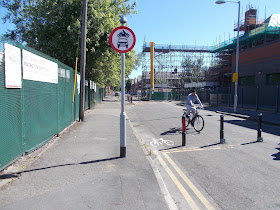It's the school holidays and so it might be worth having a whinge about the obsession that they have with two things we can add to our streets which don't really have much of an impact.
As I near the end of my local authority career, my anecdata would suggest that it is school warning signs and pedestrian guardrail which are the popular request from schools. I am not totally sure why this is, but perhaps;
- they are relatively cheap wins which appeals to the "something must be done",
- many teachers and head teachers are drivers and they come at "road safety" from a traditional motor-centric point of view (certainly an Outer-London perspective),
- they are simple 'solutions' compared to lobbying for meaningful change, especially if schools have limited resources to campaign with.
Also, being truthful, for a local authority office, putting in signs or a bit of guardrail is equally easy as it needs no consultation, looks like something is being done and it gets the school off one's back.
Over on Twitter, we often use the hashtag #SignMakeItBetter and at schools, it's no different;
The photograph above is a school warning sign on steroids. OK, it warns of a school crossing patrol, but the "patrol" plate can be swapped for "school". Just look at it, flashing amber signals, bright yellow. Fantastic.
Even with a basic warning sign, it is fairly and squarely aimed at warning drivers that there is a "hazard" ahead - that's what the triangular sign means. There is a hazard ahead and you should modify your behaviour. Great, there are kids milling about because it is school time and they are a hazard to drivers. Can't we see how upside down this is?
Warning signs are overused (at least in urban areas) to the extent where they are pretty meaningless. There might be some reactive value where a school is near a road with a speed limit of 40mph and greater, but other than that, it is reasonable to expect there are children walking to school twice a day in built up areas.
Guardrail is requested for three reasons - to stop people parking outside a school, to stop the little ones running out of the school gate and straight into the road and to stop drivers getting onto the footway (either parking or crashing).
As you can see from the photograph above, guardrail does not stop parking. In fact, it often means that children being dropped off leave the vehicle on the live traffic side and then walk along the road to the end of the guardrail. Of course, it stops parking on the footway, but so would some bollards, planters or trees.
As for physically stopping a speeding driver? Not a chance;
The most tricky one is using guardrail to stop the nippers running out into the road. I have yet to see any study which looks at the safety impacts of providing guardrail in front of school entrances. I think it's more about making people feel secure and to be fair, that's a perfectly rational safety argument - experienced safety. However, a school could equally place guardrail inside its premises to have the same impact and not take away footway space.
Perhaps a footway doesn't have enough capacity to contain the people milling around at school travel times and so some guardrail could help stop people (especially children) getting jostled into the road, although we set it back from the carriageway which means more footway lost. For me, the answer here is to make sure there is good capacity for people to get in and out of the school and if overcrowding is the issue, then more footway space is the answer.
The ultimate answer of course is to take the space outside the school away from drivers (school streets as they are often now called), such as outside Heald Place Primary School in Manchester (above) where a dozen bollards and a couple of traffic signs dealt with the problem which traffic calming, guardrail and parking controls couldn't.





No comments:
Post a Comment